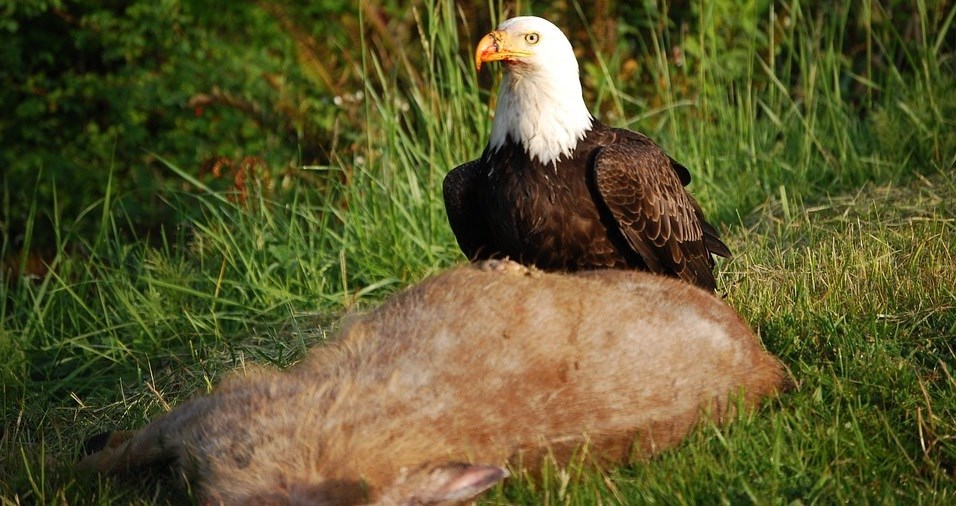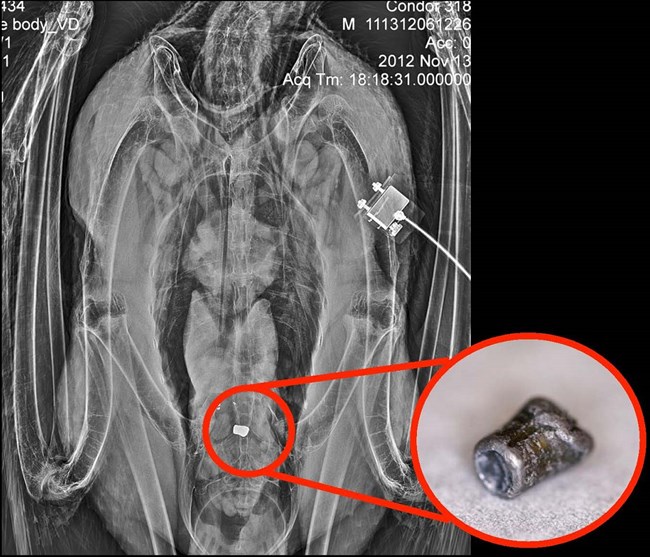
Public Domain
Across the open landscapes they call home, California condors face several distinct threats. Lead poisoning from ingestion of lead ammunition is the most significant threat to condor survival, but other factors - including ingestion of microtrash and electrocution - also present challenges to condors as a species.

Ventana Wildlife Society
Lead Poisoning
The biggest threat to condors today is lead poisoning. When a gun fires lead ammunition and it hits an animal, the soft metal breaks into many small fragments that spread beyond the wound channel. When scavengers such as condors feed on these remains, they inadvertently ingest the lead fragments. If scavengers eat enough lead, it poisons them and they can die.
Lead ammunition is commonly used in hunting and ranching operations in landscapes that are home to condors and other wildlife. Hunters often field-dress their kills, leaving gut piles behind when they take their meat home. These gut piles (and the meat itself) often contains lead fragments, even if hunters try to remove the largest pieces of the bullet. Additionally, depredation hunting (the practice of shooting “nuisance” animals such as feral pigs, ground squirrels, etc.) is common on ranches, and results in whole carcasses being left out for scavengers to consume.
Hunters are important conservation stewards. When they use non-lead ammunition, they carry on the proud tradition of protecting wildlife and ecosystems as a whole. Although condors are one of the species most commonly associated with lead poisoning, other species killed by lead ammunition poisoning include bald eagles, golden eagles, hawks, ravens, turkey vultures, and grizzly bears.
Please visit www.huntingwithnonlead.org and the Pinnacles National Park lead information page for scientific studies and more information on the threats of lead to humans and wildlife.

NPS
Microtrash
Microtrash consumption is the leading cause of death for condor nestlings. For the first six months of their lives, condor chicks are completely dependent on food their parents bring back to the nest. Along with regurgitated meat, adult condors will also bring back small bone chips to feed their young; this is probably to provide the chicks with calcium.However, sometimes the parents will bring back small pieces of trash such as bottle caps or plastic and feed it to their young, perhaps mistaking the trash for bone chips. If a chick eats enough trash, it could die.
Electrocution
Though smaller birds can safely land on power lines, condors have a wingspan that's large enough to touch both live wires at the same time, sending enough electrical current through their bodies to kill them. Electrocution was a common cause of death in the early years of the condor reintroduction program until biologists created a successful power pole aversion training program.Before young condors are released into the wild, they have access to a fake power pole in their enclosure. The pole is rigged to give the birds a light shock if they land on it. It only takes getting shocked once or twice for the condor to learn this life-saving lesson. Since they are such social birds, condors also take cues from each other to discover safe perching areas.
Other Threats
Though lead poisoning, microtrash, and electrocution are the main threats to condors, other impacts also threaten their recovery. These can include collisions with cars when condors are feeding on roadkill, rodenticide poisoning, and eggshell thinning due to DDE. Unfortunately, all of these impacts are caused by humans. Luckily, most are preventable with education and cooperation from the people who share the habitat of these magnificent birds.Last updated: February 22, 2021
